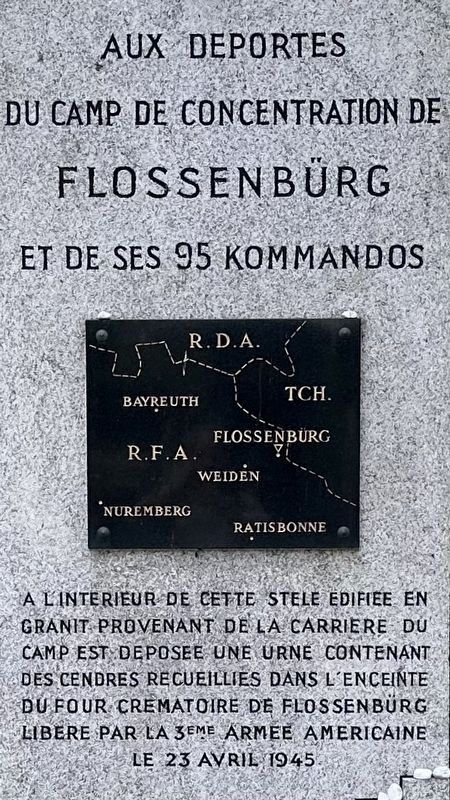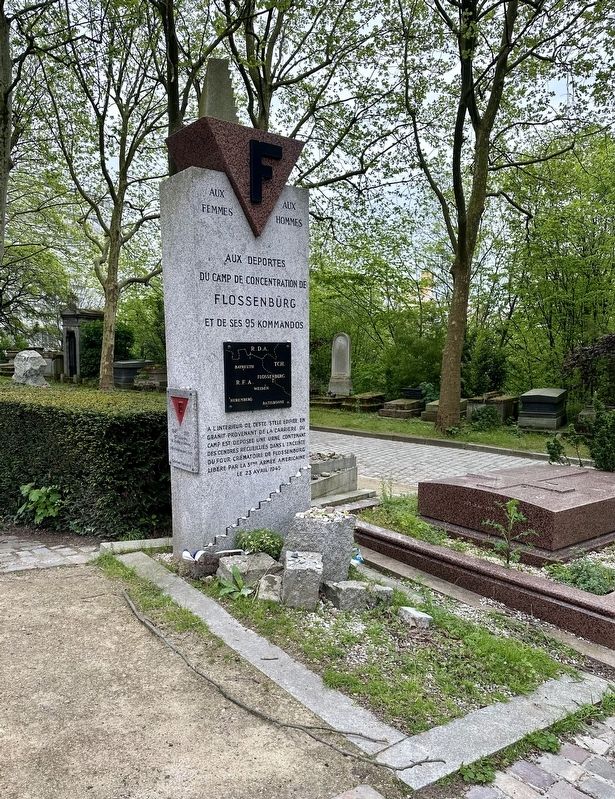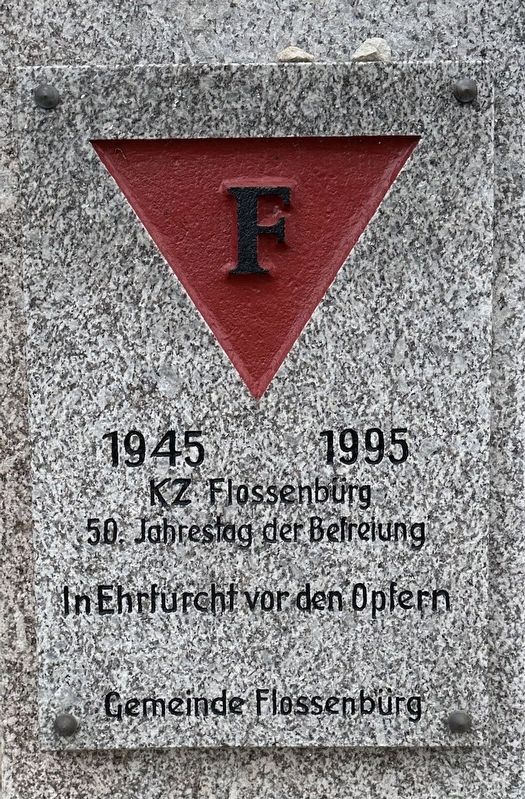Père-Lachaise in Paris in Département de Paris, Île-de-France, France — Western Europe
Flossenbürg Concentration Camp Memorial
Inscription.
Aux deportes du camp de concentration de Flossenbürg et de ses 95 kommandos
A l’interieur de cette stele edifièe en granit provenant de la carriere du camp est deposee une urne contenant des cendres recueillies dans l'enceinte du four crematoire de Flossenbürg libere par la 3eme Armee Americaine le 23 avril 1945
To the women and men, to the deportees of the Flossenbürg concentration camp and its 95 sub-camps.
Inside this stele built of granite from the camp quarry an urn was placed containing ashes collected from inside the enclosure of the crematorium of Flossenbürg, liberated on April 23, 1945 by the American Third Army.
Topics and series. This memorial is listed in this topic list: War, World II. In addition, it is included in the The Holocaust series list. A significant historical date for this entry is April 23, 1945.
Location. 48° 51.562′ N, 2° 23.944′ E. Marker is in Paris, Île-de-France, in Département de Paris. It is in Père-Lachaise. Memorial is at the intersection of Avenue Transversale No. 3 and Avenue Circulaire, on the left when traveling south on Avenue Transversale No. 3. The memorial is in Père Lachaise Cemetery in Section 77 on Avenue Traversale No. 3 right where it intersects Avenue Circulaire. Touch for map. Marker is at or near this postal address: Avenue Circulaire, Paris, Île-de-France 75020, France. Touch for directions.
Other nearby markers. At least 8 other markers are within walking distance of this marker. Mauthausen Concentration Camp Memorial (here, next to this marker); Neuengamme Concentration Camp Memorial (within shouting distance of this marker); Maurice Audin (within shouting distance of this marker); Ravensbruck Concentration Camp Memorial (within shouting distance of this marker); Communist Women’s Memorial (within shouting distance of this marker); Auschwitz-Birkenau Extermination Camp Memorial (about 90 meters away, measured in a direct line); Buchenwald-Dora Concentration Camp Memorial (about 120 meters away); Sachsenhausen-Oranienburg Concentration Camp Memorial (about 120 meters away). Touch for a list and map of all markers in Paris.
Also see . . . Flossenbürg concentration camp (Wikipedia).
Overview: Flossenbürg was a Nazi concentration camp built in May 1938 by the SS Main Economic and Administrative Office. Unlike other concentration camps, it was located in a remote area, in the Fichtel Mountains of Bavaria, adjacent to the town of Flossenbürg and near the German border with Czechoslovakia. The camp's initial purpose was to exploit the forced labor of prisoners for the production of granite for Nazi architecture. In 1943, the bulk of prisoners switched to producing Messerschmitt Bf 109 fighter planes and other armaments for Germany's war effort. Although originally intended for "criminal" and "asocial" prisoners, after Germany's invasion of the Soviet Union, the camp's numbers swelled with political prisoners from outside Germany. It also developed an extensive subcamp system that eventually outgrew the main camp.(Submitted on April 22, 2024.)
Before it was liberated by the United States Army in April 1945, 89,964 to 100,000 prisoners passed through Flossenbürg and its subcamps. Around 30,000 died from malnutrition, overwork, executions, or during the death marches. Some of those responsible for these deaths, including administrators, guards, and others, were tried and convicted in the Flossenbürg trial. The camp was repurposed for other uses before the opening of a memorial and museum in 2007.
Additional keywords. Holocaust
Credits. This page was last revised on April 22, 2024. It was originally submitted on April 22, 2024, by Andrew Ruppenstein of Lamorinda, California. This page has been viewed 48 times since then. Photos: 1, 2, 3. submitted on April 22, 2024, by Andrew Ruppenstein of Lamorinda, California.


